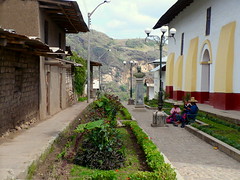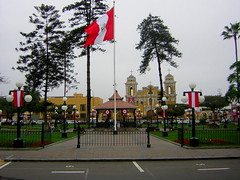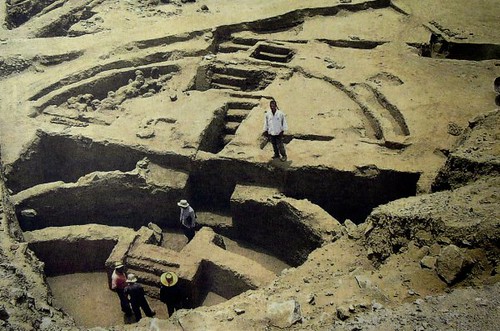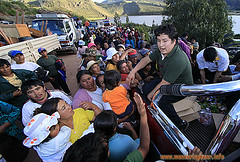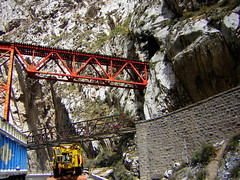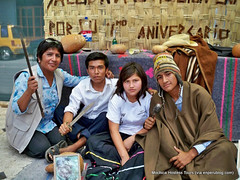Cuarto del Rescate
It was in Cajamarca that the Inca empire started down its path to swift destruction. The newly arrived group of Spanish lead by Francisco Pizarro, aiming to conquer the Inca empire, arrived in Cajamarca to be met by Emperor Atahualpa and his army. After tricking him into entering the city with only a light guard they captured him, ransomed him and killed him.
Atahualpa had been informed of the Spanish arrival via messengers. The Spanish had landed in Tumbes many weeks before and were marching south through the mountains in search of gold and any Inca capital city it might happen to reside in. Atahualpa felt little threat from this small band of strange visitors and made no effort to confront them, instead allowing them to approach Cajamarca where he was camped in the surrounding hills with his huge army. He had recently won the civil war fought against his half-brother Huascar and was traveling home to Q’osco with his battle-hardened troops.
 |
The Spanish arrived in Cajamarca on the 15th of November in 1532 and it is said Atahualpa was disturbed from bathing in the local hot springs to make a decision on what to do with the Spaniards, who in the time it took to get word to him had killed the Inca contingent in the city and any civilians found who had not fled. Perhaps Atahualpa would kill then, expel them from Inca lands, or fold them into the Inca army. (It is not true that the Incas feared the Spanish or thought of them as Gods in any way. The Incas are thought to have been well aware of strange peoples across the oceans.)
On capturing the city, Pizarro and his army had to decide what to do next. Attacking the huge army in the hills would be suicide, even with guns and horses. Retreating would not be possible as the Incas would realise the Spaniard’s weak position and pursue them. The Inca’s huge stone fortresses would be manned and any escape blocked. Doing nothing would only give the Incas time to understand and lose their fear of the Spanish weapons and armor.
Pizarro held a meeting on the evening of the 15th to devise a plan of action. The Spaniards needed to find a way to capture Atahualpa so that they could bring down the Incas as they did the Aztecs in Mexico. This would be impossible in the open field, so Pizarro decided that Atahualpa must be lured into Cajamarca and a surprise attack sprung. An Invitation was sent to Atahualpa.
 |
The next day, Atahualpa proceeded down the mountain with a lightly armed contingent of 8,000 men, leaving further tens of thousands behind. The Spaniards got lucky when Atahualpa decided the the bulk of this 8,000 would remain outside of the city walls and he would enter with only a small group of a few hundred. He requested the they all be provided with accommodation and declared that in a sign of good faith, they would enter unarmed. The Spaniards, having concealed themselves in the city allowed the Incas to enter unopposed. Almost ruining the plan for the Spanish, the Dominican friar Vincente de Valverde, approached Atahualpa and demanded that he renounce his beliefs, convert to Catholicism and swear his allegiance to Holy Roman Emperor Charles V. Confused by the demands of the friar, he explained that he wasn’t interested in handing over his empire or in the Spaniard’s religion.
Growing impatient with the Friar’s attempt to persuade Atahualpa to surrender and fearing the Friars demands would encourage Atahualpa to summon his army, the Spaniards came out from their hiding places and began massacring the unarmed Incas. More Spaniards arrived on horses, driving the fleeing Incas, who had not seen horses before, directly into gun-fire. After the massacre, Pizarro and his men found Atahualpa and a few of his nobles and guards. After a brief incident of mistaken identity, the Spaniards held Atahualpa prisoner in a building for interrogation, while the others were executed.
The Spanish charged the captured emperor with 12 crimes, including the murder of his brother Huascar, revolting against the Spanish who had granting themselves control over the Inca empire, being a pagan and practicing idolatry. He was immediately found guilty and sentenced to death by burning.
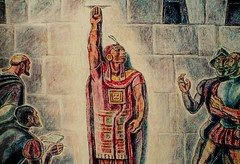 |
Realizing the greed of the Spanish, Atahualpa tried to bargain for his life. He offered to fill the room he was being held in with gold up to the reach of his arm, and two other rooms with silver in exchange for his freedom. The excited Spanish agreed, and with word to a messenger, the gold and silver was brought over the coming months to the ransom room until it was filled. The Spanish were pleased, but informed Atahualpa that the charges still stand as he hadn’t yet converted to Catholicism. Friar Vincente de Valverde again urged Atahualpa to convert as he was being led to his execution. Conversion, he said, would allow him to plead with the others to commute the sentence. Atahualpa gave in, and agreed to be baptised, after which, on August 23rd of 1533, he was strangled to death as a lesser punishment for his “crimes”.
 |
Although it cannot be said for sure, what is thought to be the “ransom room” in which Atahualpa was held still stands preserved in Cajamarca and is open to the public. The red line on the wall is said to be the level to which it was filled with gold, opposite of which is the stone on which Atahualpa was murdered.
Photos –
Tags: 1500s, atahualpa, cajamarca, catholics, conquistador, cuarto de rescate, gold, incas, pizarro, ruins, spaniards, vincente de valverde





